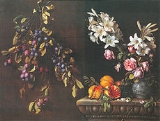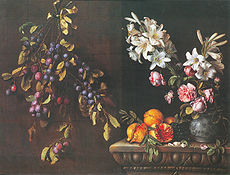
Pierre Dupuis
Encyclopedia

Montfort-l'Amaury
Montfort-l'Amaury is a commune in the Yvelines department in the Île-de-France region in north-central France. It is located in the south-western suburbs of Paris N of Rambouillet....
, March 3, 1610-Paris
Paris
Paris is the capital and largest city in France, situated on the river Seine, in northern France, at the heart of the Île-de-France region...
, February 18, 1682) was a French painter.
He lived in Italy
Italy
Italy , officially the Italian Republic languages]] under the European Charter for Regional or Minority Languages. In each of these, Italy's official name is as follows:;;;;;;;;), is a unitary parliamentary republic in South-Central Europe. To the north it borders France, Switzerland, Austria and...
, where he met Pierre Mignard
Pierre Mignard
Pierre Mignard , called "Le Romain" to distinguish him from his brother Nicolas Mignard, was a French painter...
(1612-1695) in 1637. He was a specialist of still life
Still life
A still life is a work of art depicting mostly inanimate subject matter, typically commonplace objects which may be either natural or man-made...
s and his style was influenced by Northern Europe painting and Protestant religion. In his paintings of bouquets, an influence of Jacques Linard
Jacques Linard
Jacques Linard was a French painter of the first half of the 17th century. He painted still-lives. He was baptised on the 6th of September, 1597. His first records of being of artist was in the 1620s. He was married in 1626 to the daughter of a Parisian Master Painter...
(1600-1645) and Louise Moillon
Louise Moillon
Louise Moillon was a French painter in the Baroque era. She became known as one of the best female still life painters during her time, and worked for King Charles I of England, as well as the French nobility.-Biography:...
(1610-1696). These paintings were very appreciated in his times.
Further reading
- Coatalem E., A still-life painter: PIERRE DUPUIS, The stamp. The art object, 1999, No. 335, pp. 48-55, (in French), ISSN 0998-8041, Editions Faton, Dijon, France (1989) (Revue), at INIST-CNRS, Cote INIST: 25659, 35400008348741.0030.

